ASUS P1-AH2 User Manual
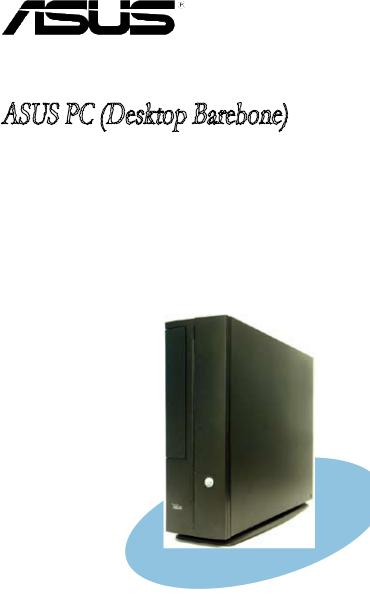
Pundit P1-AH2
ASUSPC(DesktopBarebone)
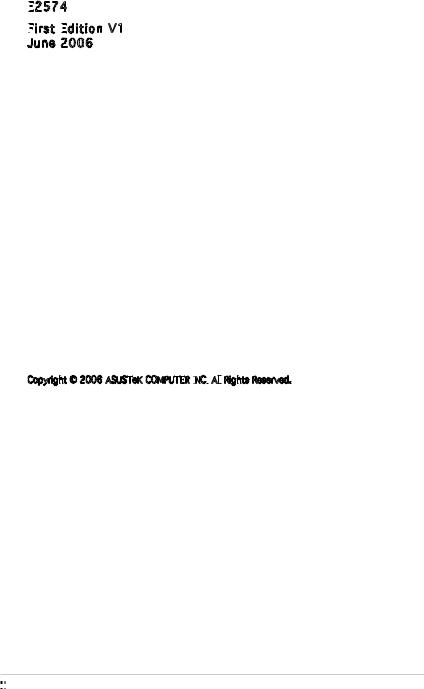
E2574

First
 Edition
Edition
 V1
V1
June 2006
Copyright © 2006 ASUSTeK COMPUTER INC.

 All
All
 Rights Reserved.
Rights Reserved.
No part of this manual, including the products and software described in it, may be reproduced, transmitted, transcribed, stored in a retrieval system, or translated into any language in any form or by any means, except documentation kept by the purchaser for backup purposes, without the express written permission of ASUSTeK COMPUTER INC. (“ASUS”).
Product warranty or service will not be extended if: (1) the product is repaired, modified or altered, unless such repair, modification of alteration is authorized in writing by ASUS; or (2) the serial number of the product is defaced or missing.
ASUS PROVIDES THIS MANUAL “AS IS” WITHOUT WARRANTY OF ANY KIND, EITHER EXPRESS OR IMPLIED, INCLUDING BUT NOT LIMITED TO THE IMPLIED WARRANTIES OR CONDITIONS OF MERCHANTABILITY OR FITNESS FOR A PARTICULAR PURPOSE. IN NO EVENT SHALL ASUS, ITS DIRECTORS, OFFICERS, EMPLOYEES OR AGENTS BE LIABLE FOR ANY INDIRECT, SPECIAL,
INCIDENTAL, OR CONSEQUENTIAL DAMAGES (INCLUDING DAMAGES FOR LOSS OF PROFITS, LOSS OF BUSINESS, LOSS OF USE OR DATA, INTERRUPTION OF BUSINESS AND THE LIKE), EVEN IF ASUS HAS BEEN ADVISED OF THE POSSIBILITY OF SUCH DAMAGES ARISING FROM ANY DEFECT OR ERROR IN THIS MANUAL OR PRODUCT.
SPECIFICATIONS AND INFORMATION CONTAINED IN THIS MANUAL ARE FURNISHED FOR INFORMATIONAL USE ONLY, AND ARE SUBJECT TO CHANGE AT ANY TIME WITHOUT NOTICE, AND SHOULD NOT BE CONSTRUED AS A COMMITMENT BY ASUS. ASUS ASSUMES NO RESPONSIBILITY OR LIABILITY FOR ANY ERRORS OR INACCURACIES THAT MAY APPEAR IN THIS MANUAL, INCLUDING THE PRODUCTS AND SOFTWARE DESCRIBED IN IT.
Products and corporate names appearing in this manual may or may not be registered trademarks or copyrights of their respective companies, and are used only for identification or explanation and to the ownersʼ benefit, without intent to infringe.
ii




Table of contents
Notices................................................................................................ |
vi |
Safety information ............................................................................. |
vii |
About this guide................................................................................. |
viii |
System package contents.................................................................... |
x |
Chapter 1: System Introduction |
|
|
1.1 |
Welcome!.............................................................................. |
1-2 |
1.2 |
Front panel .......................................................................... |
1-2 |
1.3 |
Rear panel............................................................................. |
1-4 |
1.4 |
Internal components............................................................. |
1-6 |
Chapter 2: |
Basic Installation |
|
|
2.1 |
Preparation ........................................................................... |
2-2 |
|
2.2 |
Before you proceed .............................................................. |
2-2 |
|
2.3 |
Removing the side cover ...................................................... |
2-3 |
|
2.4 |
Removing the front panel cover ........................................... |
2-4 |
|
2.5 |
Removing the storage drive assembly.................................. |
2-4 |
|
2.6 |
Removing the CPU fan and heatsink..................................... |
2-5 |
|
2.7 |
Central Processing Unit (CPU) .............................................. |
2-6 |
|
|
2.7.1 |
Overview................................................................. |
2-6 |
|
2.7.2 |
Installing CPU .......................................................... |
2-6 |
|
2.7.3 Installing the heatsink and fan................................ |
2-8 |
|
2.8 |
Installing a DIMM ................................................................... |
2-8 |
|
|
2.8.1 |
Memory configurations ........................................... |
2-8 |
|
2.8.2 Installing a DDR2 DIMM ......................................... |
2-11 |
|
|
2.8.3 Removing a DDR2 DIMM........................................ |
2-11 |
|
2.9 |
Expansion slots................................................................... |
2-12 |
|
|
2.9.1 |
PCI slots................................................................ |
2-12 |
|
2.9.2 Installing an expansion card.................................. |
2-12 |
|
2.10 |
Installing an optical drive.................................................... |
2-14 |
|
2.11 |
Reinstalling the storage drive assembly ............................. |
2-15 |
|
2.12 |
Installing the foot stand ..................................................... |
2-16 |
|
2.13 |
Reinstalling the front panel cover and the cover................ |
2-16 |
|
iii




Table of contents
Chapter 3: |
Starting up |
|
|
3.1 |
Installing an operating system.............................................. |
3-2 |
|
3.2 |
Powering up.......................................................................... |
3-2 |
|
3.3 |
Support CD information........................................................ |
3-2 |
|
|
3.3.1 Running the support CD.......................................... |
3-3 |
|
|
3.3.2 |
Utilities menu.......................................................... |
3-4 |
|
3.3.3 |
ASUS contact information ...................................... |
3-5 |
3.4 |
Software information............................................................ |
3-5 |
|
|
3.4.1 ASUS PC Probe II..................................................... |
3-5 |
|
|
3.4.2 |
DTS function......................................................... |
3-12 |
Chapter 4: Motherboard Info |
|
|
4.1 |
Introduction .......................................................................... |
4-2 |
4.2 |
Motherboard layout .............................................................. |
4-2 |
4.3 |
Jumpers ................................................................................ |
4-3 |
4.4 |
Connectors ........................................................................... |
4-5 |
Chapter 5: |
BIOS Information |
|
5.1 Managing and updating your BIOS ........................................ |
5-2 |
|
5.1.1 |
ASUS Update utility ................................................ |
5-2 |
5.1.2 Creating a bootable floppy disk.............................. |
5-5 |
|
5.1.3 ASUS EZ Flash utility .............................................. |
5-5 |
|
5.1.4 |
AwardBIOS Flash utility........................................... |
5-7 |
5.1.5 Saving the current BIOS file.................................... |
5-9 |
|
5.1.6 ASUS CrashFree BIOS utility.................................. |
5-10 |
|
5.2 BIOS setup program............................................................ |
5-11 |
|
5.2.1 |
BIOS menu screen................................................. |
5-12 |
5.2.2 |
Menu bar............................................................... |
5-12 |
5.2.3 |
Navigation keys..................................................... |
5-13 |
5.2.4 |
Menu items ........................................................... |
5-13 |
5.2.5 |
Sub-menu items.................................................... |
5-13 |
5.2.6 |
Configuration fields............................................... |
5-13 |
5.2.7 |
Pop-up window...................................................... |
5-14 |
5.2.8 |
General help .......................................................... |
5-14 |
iv


Table of contents
5.3 |
Main menu........................................................................... |
5-15 |
|
|
5.3.1 |
System Time ........................................................ |
5-15 |
|
5.3.2 |
System Date ........................................................ |
5-15 |
|
5.3.3 |
Primary IDE Master/Slave...................................... |
5-16 |
|
5.3.4 |
First/Second SATA Master ................................... |
5-18 |
|
5.3.5 |
HDD SMART Monitoring......................................... |
5-19 |
|
5.3.6 |
Installed Memory................................................... |
5-19 |
|
5.3.7 |
Usable Memory...................................................... |
5-19 |
5.4 |
Advanced menu.................................................................. |
5-20 |
|
|
5.4.1 |
CPU Configuration................................................. |
5-17 |
|
5.4.2 |
Chipset.................................................................. |
5-21 |
|
5.4.3 |
PCIPnP................................................................... |
5-22 |
|
5.4.4 |
Onboard Devices Configuration............................. |
5-23 |
5.5 |
Power menu........................................................................ |
5-26 |
|
|
5.5.1 |
ACPI Suspend Type .............................................. |
5-26 |
|
5.5.2 |
ACPI APIC Support ................................................ |
5-26 |
|
5.5.3 |
APM Configuration ................................................ |
5-27 |
|
5.5.4 |
Hardware Monitor.................................................. |
5-29 |
5.6 |
Boot menu.......................................................................... |
5-31 |
|
|
5.6.1 |
Boot Device Priority.............................................. |
5-31 |
|
5.6.2 |
Hard Disk Drive ..................................................... |
5-31 |
|
5.6.3 |
Boot Settings Configuration ................................. |
5-32 |
|
5.6.4 |
Security................................................................. |
5-33 |
5.7 |
Exit menu............................................................................ |
5-34 |
|
v

Notices
Federal

 Communications Commission Statement
Communications Commission Statement
This device complies with Part 15 of the FCC Rules. Operation is subject to the following two conditions:
•This device may not cause harmful interference, and
•This device must accept any interference received including interference that may cause undesired operation.
This equipment has been tested and found to comply with the limits for a Class B digital device, pursuant to Part 15 of the FCC Rules. These limits are designed to provide reasonable protection against harmful interference in a residential installation. This equipment generates, uses and can radiate radio frequency energy and, if not installed and used in accordance with manufacturerʼs instructions, may cause harmful interference to radio communications. However, there is no guarantee that interference will not occur in a particular installation. If this equipment does cause harmful interference to radio or television reception, which can be determined by turning the equipment off and on, the user is encouraged to try to correct the interference by one or more of the following measures:
•Reorient or relocate the receiving antenna.
•Increase the separation between the equipment and receiver.
•Connect the equipment to an outlet on a circuit different from that to which the receiver is connected.
•Consult the dealer or an experienced radio/TV technician for help.
WARNING! The use of shielded cables for connection of the monitor to the graphics card is required to assure compliance with FCC regulations. Changes or modifications to this unit not expressly approved by the party responsible for compliance could void the userʼs authority to operate this equipment.
The use of shielded cables for connection of the monitor to the graphics card is required to assure compliance with FCC regulations. Changes or modifications to this unit not expressly approved by the party responsible for compliance could void the userʼs authority to operate this equipment.
Canadian Department of Communications Statement
This digital apparatus does not exceed the Class B limits for radio noise emissions from digital apparatus set out in the Radio Interference Regulations of the Canadian Department of Communications.
This class B digital apparatus complies with Canadian ICES
apparatus complies with Canadian ICES -003.
-003.
vi


Safety information
Electrical

 safety
safety
•To prevent electrical shock hazard, disconnect the power cable from the electrical outlet before relocating the system.
•When adding or removing devices to or from the system, ensure that the power cables for the devices are unplugged before the signal cables are connected.
•If the power supply is broken, do not try to fix it by yourself. Contact a qualified service technician or your retailer.
Operation safety
•Before installing devices into the system, carefully read all the documentation that came with the package.
•Before using the product, make sure all cables are correctly connected and the power cables are not damaged. If you detect any damage, contact your dealer immediately.
•To avoid short circuits, keep paper clips, screws, and staples away from connectors, slots, sockets and circuitry.
•Avoid dust, humidity, and temperature extremes. Do not place the product in any area where it may become wet. Place the product on a stable surface.
•If you encounter technical problems with the product, contact a qualified service technician or your retailer.
Lithium-Ion Battery Warning
CAUTION: Danger of explosion if battery is incorrectly replaced. Replace only with the same or equivalent type recommended by the manufacturer. Dispose of used batteries according to the manufacturerʼs instructions.
VORSICHT: Explosionsgetahr bei unsachgemäßen Austausch der Batterie. Ersatz nur durch denselben oder einem vom Hersteller empfohlenem ähnljchen Typ. Entsorgung gebrauchter Batterien nach Angaben des Herstellers.
LASER PRODUCT WARNING
CLASS 1 LASER PRODUCT
PRODUCT

vii

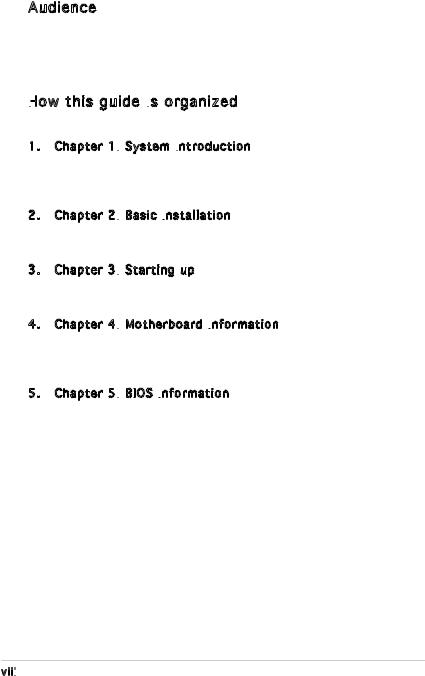
About this guide
Audience
This guide provides general information and installation instructions about the ASUS Pundit P1 - AH2 barebone system. This guide is intended for experienced users and integrators with hardware knowledge of personal computers.
How
 this guide is
this guide is organized
organized
This guide contains the following parts:
1.Chapter 1: System introduction
System introduction
This chapter gives a general description of the ASUS Pundit P1 - AH2. The chapter lists the system features, including introduction on the front and rear panel, and internal components.
2.Chapter 2: Basic installation
Basic installation
This chapter provides step-by-step instructions on how to install components in the system.
3.Chapter 3: Starting up
Starting up
This chapter helps you power up the system and install drivers and utilities from the support CD.
4.Chapter 4: Motherboard information
Motherboard information
This chapter gives information about the motherboard that comes with the system. This chapter includes the motherboard layout, jumper settings, and connector locations.
5.Chapter 5: BIOS information
BIOS information
This chapter tells how to change system settings through the BIOS Setup menus and describes the BIOS parameters.
viii

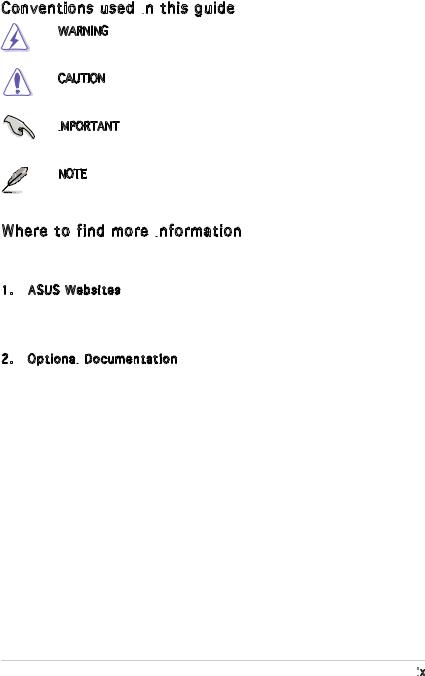
Conventions used in this guide
this guide
WARNING: Information to prevent injury to yourself when trying to complete a task.
CAUTION: Information to prevent damage to the components when trying to complete a task.
IMPORTANT: Instructions that you MUST follow to complete a task.
Instructions that you MUST follow to complete a task.
NOTE: Tips and additional information to aid in completing a task.
Where to find more information
Refer to the following sources for additional information and for product and software updates.
1.ASUS Websites
The ASUS websites worldwide provide updated information on ASUS hardware and software products. Refer to the ASUS contact information.
2.Optional
 Documentation
Documentation
Your product package may include optional documentation, such as warranty flyers, that may have been added by your dealer. These documents are not part of the standard package.
ix

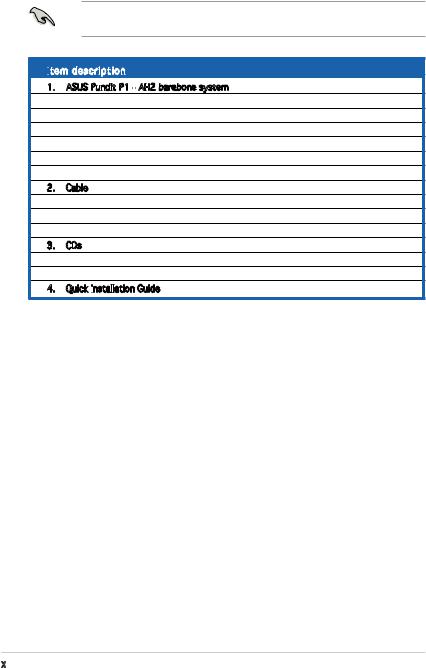
System package contents
Check your Pundit P1 - AH2 system package for the following items.
If any of the items is damaged or missing, contact your retailer immediately.
Item
 description
description
1.ASUS Pundit P1 - AH2 barebone system with
•ASUS motherboard
•CPU fan and heatsink assembly
•CompactFlash card reader
•3-in-1 storage card reader
•PCI riser card
•250W power supply unit
2.Cable
•Power cable and plug
•Serial ATA power cable and signal cable
•IDE cable
3.CDs
•Support CD
•Recover PRO CD
4.Quick installation
 Guide
Guide
x
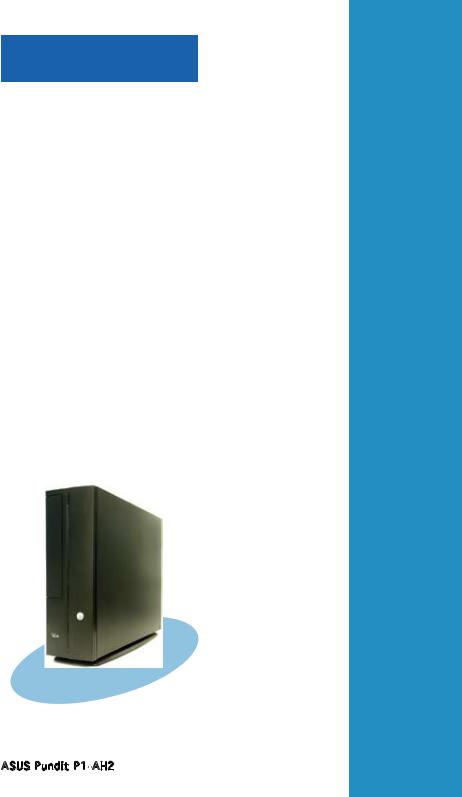
Chapter 1
This chapter gives a general description of the ASUS
Pundit P1-AH2. The chapter lists the system features including introduction on the front and rear panel, and internal components.
System introduction
ASUS Pundit P1-AH2

1.1Welcome!
Thank you for choosing the ASUS Pundit P1-AH2!
The ASUS Pundit P1-AH2 is an all-in-one barebone system with a versatile home entertainment feature.
The system comes in a stylish casing and powered by the ASUS motherboard that supports the AMD® Athlon64, AMD® Athlon 64 FX, AMD® Sempron, or AMD® Athlon 64 X2 processor.
The system supports up to 2 GB of system memory using DDR2-800/667/533/400 DIMMs, high-resolution graphics via integrated graphics controller, Serial ATA, USB 2.0, and 6-channel audio.
1.2Front panel
External |
Internal |
1
2
3
4
5
6
1
2
3
4
5
6
7
8
9
10
1-2 |
Chapter 1: System introduction |
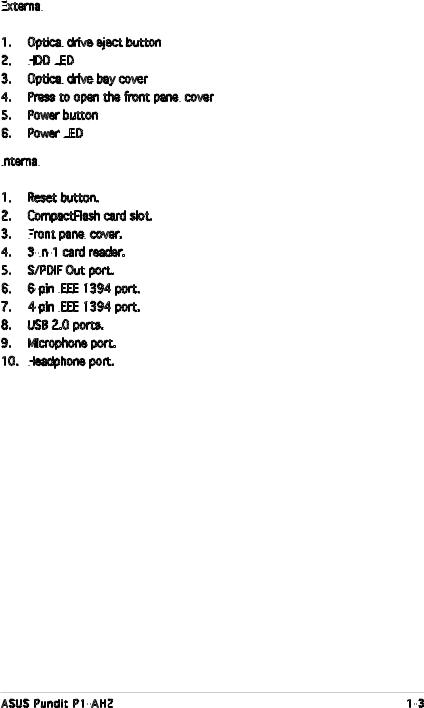
External


1.Optical drive eject button
drive eject button
2.HDD LED
LED
3.Optical drive bay cover
drive bay cover
4.Press to open the front panel cover
cover
5.Power button
6.Power LED
Internal

1.Reset button.
2.CompactFlash card slot.
3.Front
 panel
panel cover.
cover.
4.3-in -1 card reader.
-1 card reader.
5.S/PDIF Out port.
6.6-pin IEEE
 1394 port.
1394 port.
7.4-pin IEEE
 1394 port.
1394 port.
8.USB 2.0 ports.
9.Microphone port.
10.Headphone port.
port.
ASUS Pundit P1-AH2 |
1-3 |

1.3Rear panel
The system rear panel includes the power connector and several I/O ports that allow convenient connection of devices.
1
2
3
4
5
6
7
8
9
1.Power connector.
2.Line In
In port.
port.
3.Line Out port.
Out port.
4.Microphone port.
5.PS/2 keyboard port.
10
11
12
13
14
15
16
17
1-4 |
Chapter 1: System introduction |
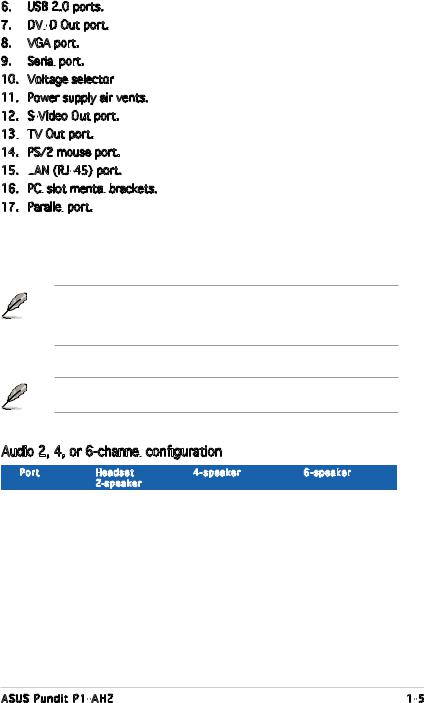
6.USB 2.0 ports.
7.DVI -D Out port.
-D Out port.
8.VGA port.
9.Serial port.
port.
10.Voltage selector
11.Power supply air vents.
12.S-Video Out port.
13.
 TV Out port.
TV Out port.
14.PS/2 mouse port.
15.LAN (RJ-45) port.
(RJ-45) port.
16.PCI slot mental
slot mental brackets.
brackets.
17.Parallel port.
port.
The systemʼs power supply unit has a115 V/230 V voltage selector switch located near the power connector. Use this switch to select the correct system input voltage according to the voltage supply in your area.
Refer to the audio configuration table below for the function of the audio ports in 2, 4, or 6-channel configuration.
Audio 2, 4, or 6-channel
 configuration
configuration
|
Port |
Headset |
4-speaker |
6-speaker |
|
|
2-speaker |
|
|
|
|
|
|
|
|
Light Blue |
Line In |
Surround Out |
Surround Out |
|
Lime |
Line Out |
Front Speaker Out |
Front Speaker Out |
|
Pink |
Mic In |
Mic |
Center/Bass |
ASUS Pundit P1-AH2 |
1-5 |
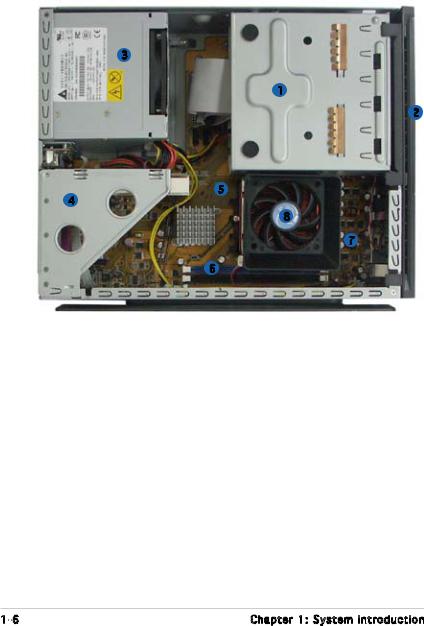
1.4Internal components
The illustration below is the internal view of the system when you remove the top cover and the power supply unit. The installed components are labeled for your reference. Proceed to Chapter 2 for instructions on installing additional system components.
3
1
2
5
4
8
7
6
1. 5.25-inch optical drive and 3.5 |
5. |
ASUS motherboard |
|
|
inch hard disk drive cage |
6. |
DIMM sockets |
2. |
Front penel cover |
7. |
CPU socket |
3. |
Power supply unit |
8. |
CPU fan and heatsink assembly |
4.PCI card riser bracket (connected to the motherboard PCI slot)
1-6 |
Chapter 1: System introduction |

Chapter 2
This chapter provides step-by-step instructions on how to install components in the system.
Basic installation
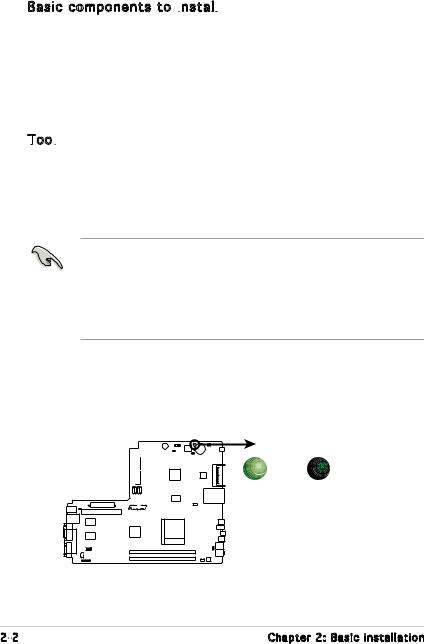
2.1Preparation
Before you proceed, make sure that you have all the components you plan to install in the system.
Basic components to install

1.Central Processing Unit (CPU)
2.DDR2 Dual Inline Memory Module (DIMM)
3.Expansion card(s)
4.Hard disk drive
5.Optical drive
Tool


Phillips (cross) screw driver
2.2Before you proceed
Take note of the following precautions before you install components into the system.
•Use a grounded wrist strap or touch a safely grounded object or
a metal object, such as the power supply case, before handling components to avoid damaging them due to static electricity.
•Hold components by the edges to avoid touching the ICs on them.
•Whenever you uninstall any component, place it on a grounded antistatic pad or in the bag that came with the component.
The motherboard comes with an onboard standby power LED. This LED lights up to indicate that the system is ON, in sleep mode or in soft-off mode, and not powered OFF. Unplug the power cable from the power outlet and make sure that the standby power LED is OFF before installing any system component.
SB_PWR
ON |
OFF |
Standby |
Powered |
Power |
Off |
Onboard LED
2-2 |
Chapter 2: Basic installation |
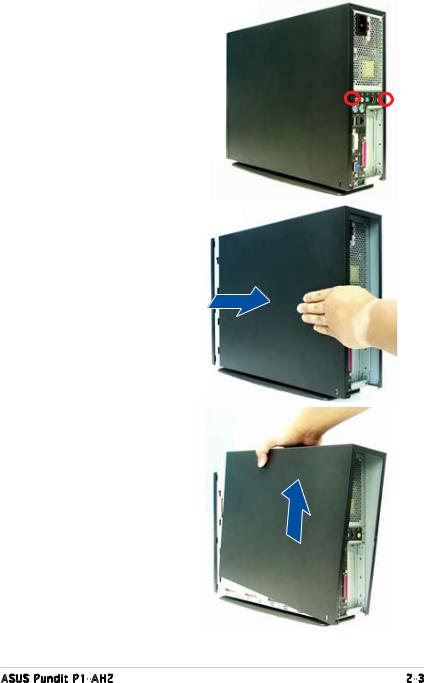
2.3Removing the side cover
1.Remove the cover screws. Keep the screws for later use.
2.Pull the cover slightly toward the rear panel.
3.Lift the cover, then set aside.
ASUS Pundit P1-AH2 |
2-3 |
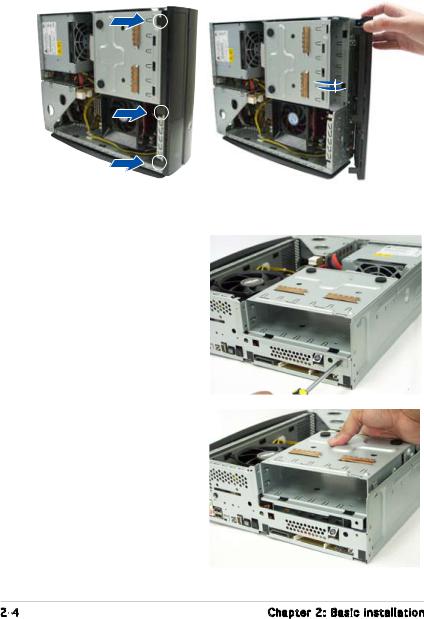
2.4Removing the front panel cover
1.Lift the front panel cover hooks outward.
2.Carefully remove the front panel cover, then set it aside.
2.5Removing the storage drive assembly
1.Lay the system on its side, then locate and remove three storage drive assembly screws.
2.Lift the storage drive assembly, then set aside.
2-4 |
Chapter 2: Basic installation |
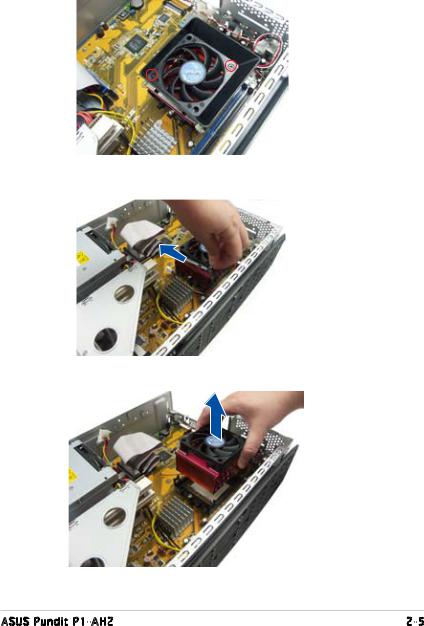
2.6Removing the CPU fan and heatsink
1.Disconnect the CPU fan cable.
2.Remove two screws securing the blower to the CPU fan. Set the blower aside.
3.Unhook and slide out the metal clips that secure the fan and heatsink assembly to the retention module.
4.Lift the CPU fan and heatsink assembly, then set aside.
ASUS Pundit P1-AH2 |
2-5 |
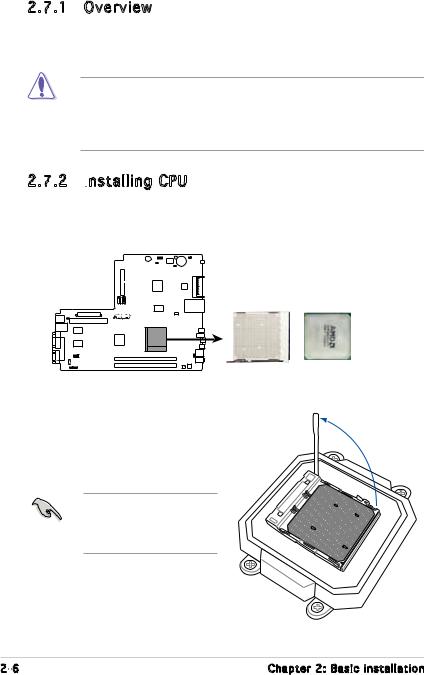
2.7Central Processing Unit (CPU)
2.7.1Overview
The motherboard comes with a 940-pin AM2 socket designed for the AMD Athlon™ 64 X2/Athlon™ 64/Sempron™ processor.
The AM2 socket has a different pinout from the 940-pin socket designed for the AMD Opteron™ processor. Make sure you use a CPU that is designed for the AM2 socket. The CPU fits in only one correct orientation. DO NOT force the CPU into the socket to prevent bending the pins the CPU!
2.7.2Installing CPU
CPU
To install a CPU:
1.Locate the CPU socket on the motherboard.
CPU Socket AM2
2.Unlock the socket by pressing the lever sideways, then lift it up to a 90º angle.
Make sure that the socket lever is lifted up to a 90º angle; otherwise, the CPU will not fit in completely.
2-6 |
Chapter 2: Basic installation |

3.Position the CPU above the socket such that the CPU corner with the gold triangle matches the socket corner with a small triangle.
4.Carefully insert the CPU into the socket until it fits in place.
5.When the CPU is in place, push down the socket lever to secure the CPU. The lever clicks on the side tab to indicate that it is locked.
6.Install a CPU heatsink and fan following the instructions that came with the heatsink package.
ASUS Pundit P1-AH2 |
2-7 |
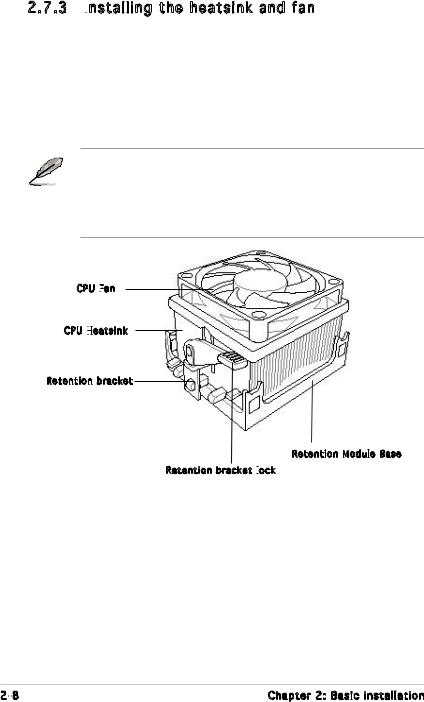
2.7.3Installing the heatsink and fan
the heatsink and fan
The AMD Athlon™ 64/AMD Athlon™ 64 X2/ AMD Sempron™ processor requires a specially designed heatsink and fan assembly to ensure optimum thermal condition and performance.
Follow these steps to install the CPU heatsink and fan.
1.Place the heatsink on top of the installed CPU, making sure that the heatsink fits properly on the retention module base.
•The retention module base is already installed on the motherboard
upon purchase.
•You do not have to remove the retention module base when installing the CPU or installing other motherboard components.
CPU Fan

CPU Heatsink

Retention bracket
Retention Module Base
Retention bracket lock

2-8 |
Chapter 2: Basic installation |
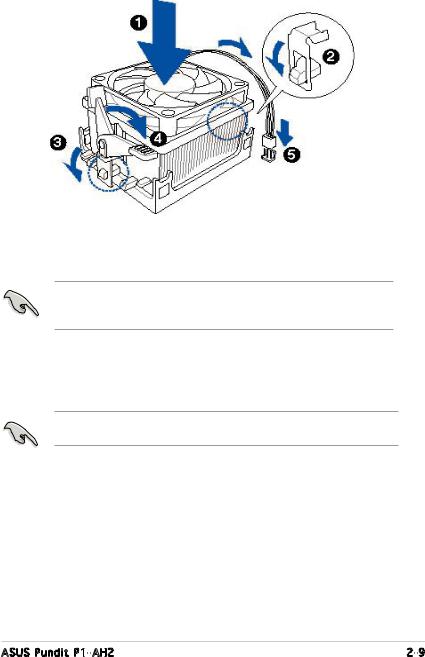
2.Attach one end of the retention bracket to the retention module base.
3.Align the other end of the retention bracket (near the retention bracket lock) to the retention module base. A clicking sound denotes that the retention bracket is in place.
Make sure that the fan and heatsink assembly perfectly fits the retention mechanism module base, otherwise you cannot snap the retention bracket in place.
4.Push down the retention bracket lock on the retention mechanism to secure the heatsink and fan to the module base.
5.When the fan and heatsink assembly is in place, connect the CPU fan cable to the connector on the motherboard labeled CPU_FAN.
Do not forget to connect the CPU fan connector! Hardware monitoring errors can occur if you fail to plug this connector.
ASUS Pundit P1-AH2 |
2-9 |
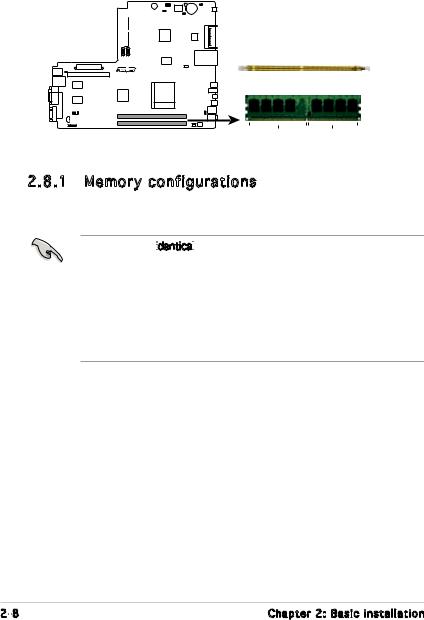
2.8Installing a DIMM
The system motherboard comes with two Double Data Rate 2 (DDR2) Dual Inline Memory Module (DIMM) sockets.
The following figure illustrates the location of the sockets:
DIMM_B1
 DIMM_A1
DIMM_A1
128 Pins |
112 Pins |
240-pin DDR2 DIMM Sockets
2.8.1Memory configurations
You may install up to 2 GB system memory using 256 MB, 512 MB, and 1 GB DDR2 DIMMs.
•Install only identical


 (the same type and size) DDR2 memory
(the same type and size) DDR2 memory
modules.
•Install only ASUS-certified memory modules. Refer to the DDR2 Qualified Vendors List on the next page for details. Visit the ASUS website for the latest DDR2 QVL.
•Always install DIMMs with the same CAS latency. For optimum compatibility, we recommend that you obtain memory modules from the same vendor.
2-8 |
Chapter 2: Basic installation |
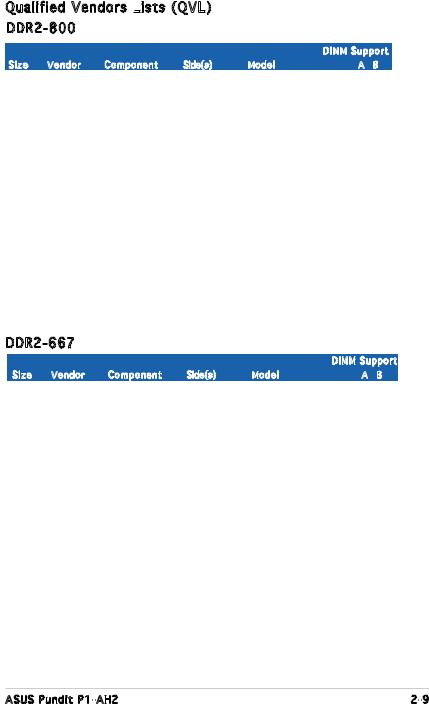
Qualified Vendors Lists
 (QVL)
(QVL)
DDR2-800
|
|
|
|
DIMM Support |
|
||
Size |
Vendor |
Component |
Side(s) |
Model |
A |
B |
|
512MB |
KINGSTON |
K4T51083QC |
SS |
KVR800D2N5/512 |
V |
V |
|
1024MB |
KINGSTON |
K4T51083QC |
DS |
KVR800D2N5/1G |
V |
|
|
512MB |
SAMSUNG |
EDD339XX |
SS |
M378T6553CZ3-CE7 |
V |
V |
|
256MB |
SAMSUNG |
K4T51163QC-ZCE7 |
SS |
M378T3354CZ3-CE7 |
V |
V |
|
512MB |
Qimonda |
HYB18T256800AF25F |
DS |
HYS64T64020HU-25F-A |
V |
V |
|
512MB |
Hynix |
HY5PS12821BFP-S5 |
SS |
HYMP564U64BP8-S5 |
V |
V |
|
1024MB |
Hynix |
HY5PS12821BFP-S5 |
DS |
HYMP512U64BP8-S5 |
|
V |
|
512MB |
MICRON |
5JAIIZ9DQQ |
SS |
MT8HTF6464AY-80EA3 |
V |
V |
|
1024MB |
MICRON |
5JAIIZ9DQQ |
DS |
MT16HTF12864AY-80EA3 |
V |
|
|
512MB |
MICRON |
5ZD22D9GKX |
SS |
MT8HTF6464AY-80ED4 |
V |
|
|
1024MB |
MICRON |
5ZD22D9GKX |
DS |
MT16HTF12864AY-80ED4 |
V |
V |
|
512MB |
MICRON |
6CD22D9GKX |
SS |
MT8HTF6464AY-80ED4 |
V |
V |
|
1024MB |
MICRON |
6CD22D9GKX |
DS |
MT16HTF12864AY-80ED4 |
|
V |
|
512MB |
CORSAIR |
Heat-Sink Package |
SS |
CM2X512A-6400 |
V |
V |
|
1024MB |
CORSAIR |
Heat-Sink Package |
DS |
CM2X1024-6400C4 |
V |
V |
|
512MB |
A-DATA |
N/A |
SS |
M2OAD6G3H3160J1E52 |
V |
V |
|
512MB |
A-DATA |
AD29608A8A-25EG |
SS |
M20AD6G3H3160I1E5E |
V |
|
|
1024MB |
Crucial |
Heat-Sink Package |
DS |
BL12864AA804.16FD |
V |
V |
|
256MB |
Apacer |
E2508AB-GE-E |
SS |
78.81091.420 |
V |
V |
|
512MB |
Apacer |
E2508AB-GE-E |
DS |
78.91091.420 |
V |
V |
|
256MB |
TwinMOS |
E2508AB-GE-E |
SS |
8G-24IK2-EBT |
V |
V |
|
|
|
|
|
|
|
|
|
DDR2-667
|
|
|
|
|
DIMM Support |
|
Size |
Vendor |
Component |
Side(s) |
Model |
A |
B |
512MB |
KINGSTON |
E5108AE-6E-E |
SS |
KVR667D2N5/512 |
V |
V |
1024MB |
KINGSTON |
E5108AE-6E-E |
DS |
KVR667D2N5/1G |
V |
V |
512MB |
KINGSTON |
E5108AE-6E-E |
SS |
KVR667D2E5/512 |
V |
V |
256MB |
KINGSTON |
HYB18T256800AF3 |
SS |
KVR667D2N5/256 |
V |
V |
256MB |
SAMSUNG |
K4T51163QC-ZCE6 |
SS |
M378T3354CZ0-CE6 |
V |
V |
512MB |
SAMSUNG |
ZCE6K4T51083QC |
SS |
M378T6553CZ0-CE6 |
V |
V |
1024MB |
SAMSUNG |
ZCE6K4T51083QC |
DS |
M378T2953CZ0-CE6 |
V |
V |
256MB |
Qimonda |
HYB18T512160AF-3S |
SS |
HYS64T32000HU-3S-A |
V |
V |
512MB |
Qimonda |
HYB18T512800AF3S |
SS |
HYS64T64000HU-3S-A |
V |
V |
1024MB |
Qimonda |
HYB18T512800AF3S |
DS |
HYS64T128020HU-3S-A |
V |
V |
256MB |
Qimonda |
HYB18T512160BF-3S |
SS |
HYS64T32000HU-3S-B |
|
V |
512MB |
Qimonda |
HYB18T512800BF3S |
SS |
HYS64T64000HU-3S-B |
V |
V |
1024MB |
Qimonda |
HYB18T512800BF3S |
DS |
HYS64T128020HU-3S-B |
V |
V |
256MB |
ELPIDA |
E2508AB-6E-E |
SS |
EBE25UC8ABFA-6E-E |
V |
V |
512MB |
ELPIDA |
E5108AE-6E-E |
SS |
EBE51UD8AEFA-6E-E |
V |
V |
512MB |
A-DATA |
AD29608A8B-3EG |
SS |
M20AD5Q3H3163J1C52 |
V |
V |
512MB |
Transcend |
E5108AE-6E-E |
SS |
TS64MLQ64V6J |
V |
V |
1024MB |
Transcend |
E5108AE-6E-E |
DS |
TS128MLQ64V6J |
V |
V |
ASUS Pundit P1-AH2 |
2-9 |
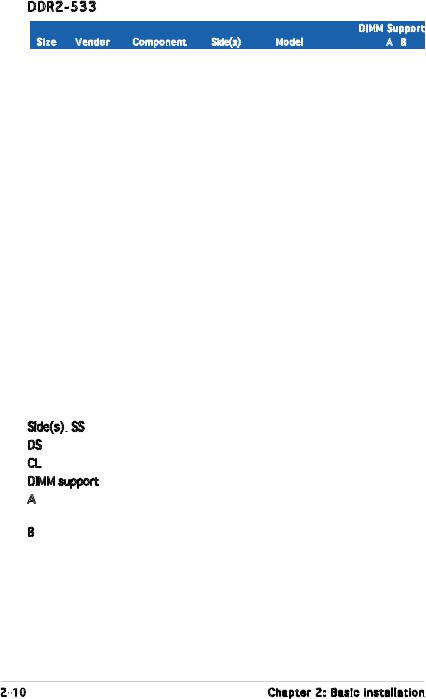
DDR2-533
|
|
|
|
|
DIMM Support |
|
Size |
Vendor |
Component |
Side(s) |
Model |
A |
B |
256MB |
KINGSTON |
E5116AF-5C-E |
SS |
KVR533D2N4/256 |
V |
V |
512MB |
KINGSTON |
HYB18T512800AF37 |
SS |
KVR533D2N4/512 |
V |
V |
1024MB |
KINGSTON |
5YDIID9GCT |
DS |
KVR533D2N4/1G |
V |
V |
512MB |
Infineon |
HYB18T512800AC37 |
SS |
HYS64T64000GU-3.7-A |
V |
V |
256MB |
Infineon |
HYB18T512160AF-3.7 |
SS |
HYS64T32000HU-3.7-A |
V |
V |
512MB |
Infineon |
HYB18T512800AF37 |
SS |
HYS64T64000HU-3.7-A |
V |
V |
1024MB |
Infineon |
HYB18T512800AF37 |
DS |
HYS64T128020HU-3.7-A |
V |
V |
2048MB |
Infineon |
HYB18T1G800AF-3.7 |
DS |
HYS64T256020HU-3.7-A |
V |
V |
256MB |
Infineon |
HYB18T5121608BF-3.7 |
SS |
HYS64T32000HU-3.7-B |
V |
V |
512MB |
Infineon |
HYB18T512800BF37 |
SS |
HYS64T64000HU-3.7-B |
V |
V |
1024MB |
Infineon |
HYB18T512800BF37 |
DS |
HYS64T128020HU-3.7-B |
V |
V |
512MB |
Hynix |
HY5PS12821F-C4 |
S |
HYMP564U648-C4 |
V |
V |
1024MB |
Hynix |
HY5PS12821F-C4 |
DS |
HYMP512U648-C4 |
V |
V |
1024MB |
Hynix |
HY5PS12821FP-C4 |
DS |
HYMP512U648-C4 |
V |
V |
512MB |
Hynix |
HY5PS12821AFP-C3 |
SS |
HYMP564U64AP8-C3 |
V |
V |
1024MB |
Hynix |
HY5PS12821AFP-C3 |
DS |
HYMP512U64AP8-C3 |
V |
V |
512MB |
ELPIDA |
E5108AB-5C-E |
SS |
EBE51UD8ABFA-5C |
V |
V |
512MB |
ELPIDA |
E5108AB-5C-E |
SS |
EBE51UD8ABFA-5C-E |
V |
V |
1024MB |
ELPIDA |
E5108AB-5C-E |
DS |
EBE11UD8ABFA-5C-E |
V |
V |
2048MB |
ELPIDA |
E1108AA-5C-E |
DS |
EBE21EE8AAFA-5C-E |
V |
|
256MB |
CORSAIR |
MIII0051832M8CEC |
SS |
VS256MB533D2 |
|
V |
512MB |
CORSAIR |
MI110052432M8CEC |
DS |
VS512MB533D2 |
V |
V |
256MB |
Apacer |
E5116AB-5C-E |
SS |
78.81077.420 |
V |
V |
256MB |
KINGMAX |
E5116AB-5C-E |
SS |
KLBB68F-36EP4 |
V |
V |
512MB |
KINGMAX |
E5108AE-5C-E |
SS |
KLBC28F-A8EB4 |
V |
V |
1024MB |
KINGMAX |
E5108AE-5C-E |
DS |
KLBD48F-A8EB4 |
V |
V |
512MB |
KINGMAX |
KKEA88E4AAK-37 |
SS |
KLBC28F-A8KE4 |
V |
V |
1024MB |
KINGMAX |
5MB22D9DCN |
DS |
KLBD48F-A8ME4 |
V |
V |
512MB |
Transcend |
K4T51083QB-GCD5 |
SS |
TS64MLQ64V5J |
V |
V |
1024MB |
Transcend |
K4T51083QB-GCD5 |
DS |
TS128MLQ64V5J |
V |
V |
|
|
|
|
|
|
|
Side(s): SS - Single-sided
SS - Single-sided
DS - Double-sided
CL: CAS Latency
DIMM support:
A -Supports one module inserted into either slot, in Single-channel memory configuration.
B -Supports one pair of modules inserted into both slots as one pair of Dual-channel memory configuration.
2-10 |
Chapter 2: Basic installation |
